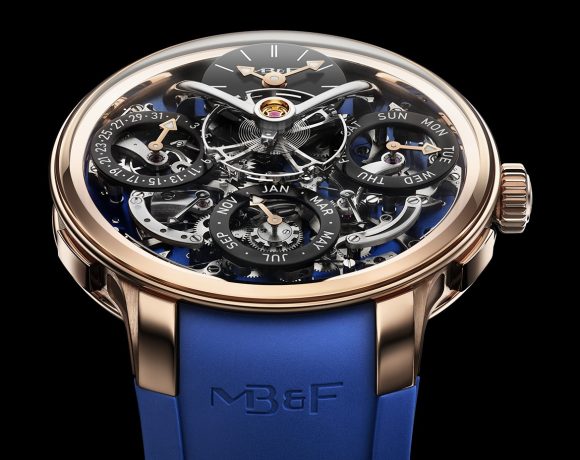How well do you know your high-end watchmaking terms?

Read on to get up to speed
Discover the intricate world of high-end watchmaking with this comprehensive A-Z glossary.
Each term illuminates the craftsmanship, technology, and artistry behind luxury timepieces, from fundamental components to advanced complications. This essential resource enhances enthusiasts’ and collectors’ understanding and appreciation of horology.
Amplitude
Deflection (angle) is traversed by the oscillating balance between its dead centre and two reversal points.
Analogue
A watch that shows the time using hour and minute hands.
Analogue digital display
A watch that shows the time using hour and minute hands (analogue display) as well as by numbers (digital display).
Anti-reflection
A film is created by steaming the crystal to eliminate light reflection and improve legibility. Anti-reflection functions best when applied to both sides of the crystal, but some manufacturers prefer to have it only on the interior because it scratches.
Aperture
Small opening. The dials of some watches have apertures in which specific indications are given (e.g. the date, the hour, etc).
Appliqué
Appliqué or applied chapters are numerals or symbols cut out of sheet metal and stuck or riveted to a dial.
Arabic numerals
1, 2, 3, etcetera, Arabic numerals, which first appeared on watch dials towards the 18th century, allow greater scope for fantasy than their Roman counterparts. Most fine-quality watch companies use Arabic and Roman numerals without distinction.
Art Deco
An artistic current began in 1925 with the International Decorative Arts Exhibition in Paris.
Assembling
The process of fitting together the components of a movement was formerly entirely by hand, but the operations have now been largely automated.
Assortment
French term for the parts used for making an escapement.
Automatic winding (or self-winding)
This term refers to a watch with a mechanical movement (as opposed to a quartz or electrical movement). The watch is wound by the motion of the wearer’s arm rather than through turning the winding stem. A rotor that turns in response to motion winds the watch’s mainspring. If an automatic watch is not worn for a day or two, it will wind down and needs to be wound by hand to get it started again.
Autonomy
The length of time a clock or watch can function between windings.
ATM (atmosphere)
A unit of measure to indicate a watch’s water resistance, precisely its capacity to resist pressure, is based on standard atmospheric pressure, defined as 101.325 kilopascals (kPa), equivalent to approximately 1 bar. It can be expressed differently: 10 atm = 10 bars = 100 metres.
Balance
The moving part, usually circular, oscillates about its axis of rotation. The hairspring coupled to it makes it swing to and fro, dividing time into exactly equal parts. Each of the to-and-fro movements of the balance (“tick-tack”) is called an “oscillation”. One oscillation is composed of 2 vibrations.
Balance cock
A small metal plate was screwed to the visible side of the movement. It carries the balance wheel shaft bearing.
Bar lug
In wristwatch cases, a thin metal rod is fixed between the horns to attach the wristlet.
Barrel
Thin cylindrical box containing the mainspring of a watch. The toothed rim of the barrel drives the train.
Bezel
The bezel is the ring that surrounds the watch dial (or face). It is usually made of gold, gold plate, or stainless steel.
Bi-directional rotating bezel
A bezel that can be rotated either clockwise or counterclockwise. These are used for mathematical calculations such as average speed or distance (see “slide rule”) or for keeping track of elapsed time(see “elapsed time rotating bezel”).
Blued steel
Steel parts are slowly and cautiously heated to about 300ºC, coating them with a fragile, shimmering film of cornflower-blue magnetite.
Bridge
The complementary part is fixed to the main plate to form the frame of a watch movement. The other parts are mounted inside the frame (part of the “ébauche”).
Cabochon
A polished, precious, or fine stone cut into a dome without facets decorates a watch dial and sometimes the crown.
Calendar
A feature that shows the date and often the day of the week. There are several types of calendar watches. Most calendar watches show the information digitally through an aperture on the watch face. Some chronograph watches show the information on sub-dials on the watch face.
Calibre
Originally used to mean the size of a watch movement, this term now denotes a type of movement (men’s calibre, automatic calibre, etc). When the manufacturer’s mark accompanies a calibre number, it serves as an indication of origin.
Carat
Also, karat. The unit of measurement of the purity of a gold alloy. A 1-carat alloy contains 1/24th of its weight in pure gold. An 18-carat alloy is 18/24th pure gold. Pure gold is 24 carats, the unit of weight for precious stones. One carat equals 0.20 grams. Gold is made in several carats, or 1/24th the proportions of gold, to make it more complex and resistant to daily wear.
Casing up
Process of inserting and fixing a watch movement into its case.
Chablon
French term for a watch movement (not including the dial and hands), of which all or part of the components are not assembled.
Chamfering
Also: angling, bevelling. The breaking and polishing of sharp edges on bridges and levers.
Chronograph
A watch equipped with a separate measuring mechanism and a separate seconds hand (chrono hand) that allows the measurement of short time intervals ( stopped time).
Chronometer
A Swiss watch labelled as a chronometer will most certainly have mechanical movement of the very highest quality, and it has undergone a series of precision tests at an official institute. The requirements are severe: a few seconds per day in the most unfavourable temperature conditions (for mechanical watches) and ordinarily encountered positions.
Clous de Paris
A guilloché pattern on the dial of hollowed lines that intersect to form tiny pyramidal shapes.
Cloisonné
An enamelling technique in which the subject’s outline is formed by thin, flat metal wires set on the surface to be enamelled to create cells.
Column wheel
Also: ratchet wheel, pillar wheel. A steel switching wheel with upright columns controls all critical switching operations in a chronograph mechanism.
Complication
A complication is a wristwatch function beyond that required for simple hours, minutes, and seconds. More practically, common additions such as a day/date window are typically excluded from this definition.
C.O.S.C.
Also, COSC. The Contrôle Officiel Suisse de Chronomètrage (C.O.S.C.) is the official Swiss testing office for chronometers. The C.O.S.C. is the world’s largest issuer of so-called chronometer certificates. For a fee, the C.O.S.C. tests the rate of movements that watchmakers have adjusted. Those that meet the specifications for being a chronometer are awarded an official certificate.
Côtes de Genève
Like waves, a decoration of undulating lines is frequently used to embellish superior-quality movements.
Countdown timer
A function that lets the wearer keep track of how much of a pre-set period has elapsed. Some countdown timers sound a warning signal a few seconds before the time runs out.
Crown
Also called a stem or pin, a crown is a knob/button on the outside of the watch case that is used to set the time and date. In a mechanical watch, the crown also winds the mainspring. In this case, it is also called a “winding stem”. A screw-in (or screw-down) crown makes a watch more water-resistant. The crown screws into the case, dramatically increasing the water-tightness of the watch.
Crystal
The transparent cover on a watch face is made of glass crystal, synthetic sapphire or plastic. Better watches often have a sapphire crystal that is highly resistant to scratching or shattering.
Dauphine hand
A type of hand in the form of an elongated triangle.
Dial
The watch face (plate of metal or other material). Dials vary significantly in shape, decoration, material, etc. Numerals, divisions, or symbols of various types give the indications.
Digital watch
A watch that shows the time through digits rather than through a dial and hands (analogue) display.
Direct-drive
It refers to a second hand that moves forward in little jerks.
Display
Indication of time or other data, either using hands moving over a dial (analogue display) or using numerals appearing in one or more windows (digital or numerical display); these numerals may be completed by alphabetical indications (alphanumerical display) or by signs of any other kind. Example: 12.05 MO 12.3 = 12 hours, 5 minutes, Monday 12th March. Such displays can be obtained by mechanical or electronic means.
Diving watch
A watch that is water resistant to 200 metres. Has a 1-way rotating bezel and a screw-on crown and back. Has a metal or rubber strap (not leather). Has a sapphire crystal and, possibly, a wet-suit extension.
Dual time zone
Describes a watch that simultaneously gives the time in two time zones, usually local and the wearer’s home.
Ebauche
French term (but commonly used in English-speaking countries) for a movement blank, i.e. an incomplete watch movement, which is sold as a set of loose parts comprising the main plate, the bridges, the train, the winding and setting mechanism and the regulator. However, the timing system, the escapement and the mainspring are not parts of the ‘ébauche’.
Elapsed time rotating bezel
A graduated rotating bezel (see “rotating bezel”) tracks elapsed time. The bezel can be turned so the wearer can align the zero on the bezel with the watch’s seconds or minutes hand. After some time passes, you can read the bezel’s elapsed time. This saves you from having to perform the subtraction that would be necessary if you used the watch’s regular dial.
Escapement
Device in a mechanical movement that controls the rotation of the wheels and thus the motion of the hands. Set of parts (escape wheel, lever, roller), which converts the rotary motion of the train into to-and-fro motion (the balance).
Escape wheel
Together with the lever, it constitutes the escapement. It is the last wheel in the going train.
Etablissage
French term for manufacturing watches and/or movements by assembling their various components.
Etablisseur
French term for a watch factory engaged only in assembling watches, without producing the components, which it buys from specialist suppliers.
Equation of time
The mean time used to keep track of the day’s passing (24 hours evenly divided into minutes and seconds) is not equal to accurate solar time. The equation of time is a complication devised to show the difference between the mean time displayed on a wristwatch and the time the sun dictates.
Factory works
In the Swiss watch industry, the term ‘manufacture’ denotes a factory in which watches are manufactured almost entirely, as distinct from an ‘atelier de terminate’, which is concerned only with assembling, timing, and fitting the hands and casing.
Feuille
A hand in the form of a leaf.
Fly back hand
In a chronograph with an analogue display, an additional centre second hand can remain superposed on the other one as it moves, can be stopped independently and then made to “fly back” to catch up with the other hand, or can be stopped and reset to zero together with the other hand. A “function” has the same effect in chronographs with numerical display.
Glass crystal
A thin glass plate or transparent synthetic material protects the dials of watches, clocks, etc.
GMT
GMT, or Greenwich Mean Time, is based on the globe’s division into 24 time zones. GMT often describes a wristwatch with a second-time zone or a 24-hour indication.
Gold-plated
A layer of gold electroplated to a base metal.
Going train
Also, a gear train assembles wheels and pinions that transmit energy from the mainspring barrel to the escapement.
Gold chaton
The gold setting of a bearing jewel. Chatons are often secured to a 3-quarter plate with 2 or 3 screws.
Guilloché
Surface decoration is usually applied to the dial and the rotor using a grooving tool with a sharp tip, such as a rose engine, to cut an even pattern on a level surface.
Hand
An indicator is usually made of a thin, light piece of metal, very variable in form, which moves over a graduated dial or scale. Watches usually have three hands showing the hours, minutes and seconds.
Integrated bracelet
A watch bracelet is incorporated into the design of the case.
Jewels
Synthetic sapphires or rubies act as bearings for gears in a mechanical watch. The jewels reduce friction to make the watch more accurate and longer-lasting. They are generally made of synthetic material, except for the precious or semi-precious stones (ruby, sapphire, garnet) sometimes used in luxury watches.
Jumping seconds
Also, flying seconds, jumping hand. On an old chronograph, a hand that makes one rotation every second, pausing four, five, or even eight times to indicate quarters, fifths, or eighths of a second. It is also called’ foudroyant’ in French.
Jumping hour
A means of display in which the hour, shown through an aperture, instantly changes every 60 minutes.
Kinetic
This innovative technology uses a quartz movement that does not use a battery. The wrist’s movement charges a very efficient capacitor that powers the quartz movement.
Lap timer
The watch has a chronograph function that lets the wearer time segments of a race. He stops the timer at the end of a lap and returns it to zero to begin timing the next lap.
Liquid crystal display (LCD)
An LCD watch is a digital watch display that shows the time electronically. It uses a liquid held in a thin layer between two transparent plates. All LCD watches have quartz movements.
Lugs
Projections on a watch face to which the watchband or bracelet is attached.
Lever
Also: pallet lever, escape lever. This part of the escapement looks like a ship’s anchor. It prevents the train from spinning freely and thereby causes the characteristic ticking of a mechanical watch.
Main plate
The base plate on which all the other parts of a watch movement are mounted.
Mainspring
The driving spring of a watch or clock is contained in the barrel.
Manufacture
A company that manufactures at least one calibre, or essential parts of it, such as the base plate, on-premises.
Manufacture d’horlogerie
The French term for a watch factory producing the components (particularly the ‘ébauches’) needed to manufacture its products.
Mechanical movement
A movement powered by a mainspring, working in conjunction with a balance wheel. Most watches today have electronically controlled quartz movements and are powered by a battery. However, mechanical watches are currently enjoying a resurgence in popularity.
Minute repeater
A striking mechanism with hammers and gongs for acoustically signalling the hours, quarter hours and minutes elapsed since noon or midnight.
Mainspring
The driving spring of a watch or clock is contained in the barrel.
Middle of a watch case
The middle part of the case, in which the movement is fitted.
Movement
The assembly consists of the principal elements and mechanisms of a watch or clock: the winding and setting mechanism, the mainspring, the train, the escapement, and the regulating elements. “Anatomically, the movement consists of the “ébauche,” the regulating elements, and the other components. The inner mechanism of a watch keeps time and moves the watch’s hands, calendar, etc. Movements are either mechanical or quartz.
Paillon
A tiny motif cut out of gold or silver decorates enamelwork.
Perlage
Also, circular graining is a cloud-like decoration on plates and bridges. It is produced by stippling the surface with a small rotating grinding wheel.
Perpetual calendar
A calendar that automatically accounts for the different number of days in months and leap years. With a few rare exceptions, it must be adjusted for secular years that are not leap years, the next being 2100 and 2200. A 48-month dial, derived from pocket watches, corresponds to three non-leap years and one leap year. On the more legible 12-month dial, a hand or aperture shows non-leap and leap years.
Poinçon de Genève
A distinctive hallmark depicting the Geneva coat of arms, granted by an official body at the Ecole d’Horlogerie de Genève and placed on movements whose quality and finish conform to precise criteria—created in 1886 by the State of Geneva.
Plate
A metal platform has several tiers for the gear train.
Power reserve indicator
A power reserve indicator displays the state of the main spring’s wind. It reminds the watch owner that the movement must be rewound before it stops.
Quartz movement
A movement powered by a quartz crystal is very accurate. Quartz crystals can be mass-produced, which makes them less expensive than most mechanical movements that require a higher degree of craftsmanship.
Retrograde
An hour, minute, second or calendar hand moves across a scale and, at the end of its cycle, returns immediately to zero to begin again.
Roman numerals
I, II, III, etc. Roman numerals have traditionally been used on clock and watch dials. IV is often given as I to create visual symmetry with VIII. Only the IX is written using the subtractive principle.
Rotor
The part of an automatic (or self-winding) mechanical watch winds the movement’s mainspring. It is a flat piece of metal, usually shaped like a semicircle, that swivels on a pivot with the motion of the wearer’s arm.
Rotating bezel
A bezel (the ring surrounding the watch face) that can be turned. Different types of rotating bezels perform different timekeeping and mathematical functions.
Rattrapante function
A rattrapante hand is a second hand that can be stopped independently of the Chrono sweep-seconds hand. After it has been stopped (to record a lap time, for instance), it can be restarted, and then it will instantly catch up and synchronise with the Chrono sweep second-hand.
Repeater
A watch that strikes the hours uses a mechanism operated by a push-piece or bolt. There are various types of repeaters. Quarter-repeater: sounding a low note for the hours and a “ding-dong” for each of the quarters; Five-minute repeater: striking the hours, quarters and five-minute periods after the quarter; Minute-repeater: striking the hours, quarters and minutes; Grande sonnerie (grand strike): striking the hours and quarters automatically and repeating when a push-piece is pressed down; Chiming repeater: in which the quarters are struck on three or four gongs of different pitch.
Reserve de Marche
‘Reserve de Marche’, French for power reserve, is an indicator that displays the approximate number of days or hours left on the current state of mainspring wind.
Rotor
Half-disc of heavy metal, which is made to rotate inside the case of an automatic watch by the energy produced by the movements of the wearer’s arm. Its weight tends always to bring it back to the vertical position. Demultiplied by a specially designed device, its rotations continually wind the watch’s mainspring.
Sapphire crystal
A crystal made of synthetic sapphire, a transparent, shatter-resistant, scratch-resistant substance.
Screw balance
A balance wheel that has adjustable screws along its rim
Screw-lock crown
A crown that can be screwed into the case to make the watch watertight.
Seal of Geneva
Since 1886, the seal of the canton of Geneva has been awarded to Genevan watch manufacturers. These manufacturers must follow a set of high-quality criteria, including polished jewel bed drillings and winding wheels.
Shock absorber
Resilient bearing, which, in a watch, is intended to take up the shocks the balance staff receives, thus protecting its delicate pivots from damage.
Skeleton watch
A watch in which the case and various parts of the movement are of transparent material, enabling the main parts of the watch to be seen.
Sonnerie
A variety of minute repeaters that – like a clock – sound the time not at the will of the wearer but rather automatically (en passant) every hour (petite sonnerie) or quarter hour (grande sonnerie).
Stopwatch
A timekeeping instrument can be used to measure intervals of time. When this is done, the time display is partly or wholly lost until the hands are reset.
Second-time zone indicator
An additional dial can be set to the time in another time zone. This lets the wearer keep track of local time and time in another country.
Shock resistance
US government regulation defines a watch’s ability to withstand an impact as equal to that of being dropped onto a wooden floor from a height of 3 feet.
Slide rule
A device consisting of logarithmic or other scales on the outer edge of the watch face that can be used to do mathematical calculations. One of the scales is marked on a rotating bezel, which can be slid against the stationary scale to make the calculations. Some watches have slide rules that allow specific calculations, such as fuel consumption by an aeroplane or fuel weight.
Solar powered
A watch that uses solar energy (from any light source) to power the quartz movement.
Stepping motor
The part of a quartz movement that moves the gear train, which in turn moves the watch’s hands.
Stopwatch
A watch with a second hand that measures intervals of time. When a stopwatch is incorporated into a standard watch, the stopwatch function and the timepiece are referred to as a chronograph.
Sub-dial
A small dial on a watch face is used for several purposes, such as keeping track of elapsed minutes or hours on a chronograph or indicating the date.
Tachometer
Also: tachymeter. A feature on chronograph watches measures the speed at which the wearer has travelled over a measured distance. In watchmaking, a timer or chronograph with a graduated dial on which speed can be read off in kilometres per hour or some other unit (see “timer”).
Three-quarter plate
A three-quarter plate accommodates the counter-bearing of the going train and enhances the stability of the movement.
Titanium
A metal that is used for some watch cases and bracelets. Titanium is much stronger and lighter than stainless steel. Titanium is also hypoallergenic.
Tonneau watch
A watch shaped like a barrel with two convex sides.
Tourbillon
A system devised and constructed by Abraham-Louis Breguet in 1798 to compensate for errors of rate caused by the Earth’s gravitational force in upright positions. The escapement is mounted in a revolving cage with the regulating organ (balance) at the centre. The escape-wheel pinion turns about the fixed fourth wheel. The cage usually revolves once a minute and, in doing so, compensates for errors of rate caused by the vertical position in which pocket watches spend most of their time. This delicate and complex structure is one of watchmaking’s most ingenious mechanisms.
Unidirectional rotating bezel
An elapsed-time rotating bezel (see “elapsed-time rotating bezel”), often found on divers’ watches, moves only counterclockwise. It is designed to prevent a diver who has unwittingly knocked the bezel off its original position from overestimating his remaining air supply. Because the bezel moves in only one direction, the diver can err only on the side of safety when timing his dive. Many divers’ watches are ratcheted to lock into place for more excellent safety.
Vibration
Movement of a pendulum or other oscillating element, limited by two consecutive extreme positions. The balance of a mechanical watch generally makes five or six vibrations per second (i.e. 18,000 or 21,600 per hour), but that of a high-frequency watch may make seven, eight or even ten vibrations per second (i.e. 25,200, 28,800 or 36,000 per hour).
Watch case
Container that protects the watch movement from dust, dampness and shocks. It also gives the watch as attractive an appearance as possible.
Winding
The operation consists of tightening the mainspring of a watch. This can be done by hand (using the crown) or automatically (using a rotor, which is caused to swing by the movements of the wearer’s arm).
Water-resistant
The ability to withstand splashes of water. Terms such as “water resistant to 50 meters” or “water resistant to 200 metres” indicate that the watch can be worn underwater to various depths.
Winding stem
The button on the right side of the watch case, also called a ‘crown,’ winds the mainspring.
World time dial
A dial, usually on the watch face’s outer edge, tells the time in up to 24 time zones worldwide. The time zones are represented by the names of cities printed on the bezel or dial. The wearer reads the hour in a particular time zone by looking at the scale next to the town the hour hand is pointing to. The minutes are read as usual.
Featured image: Ebauche is a French term for a movement blank, i.e. an incomplete watch movement, which is sold as a set of loose parts












